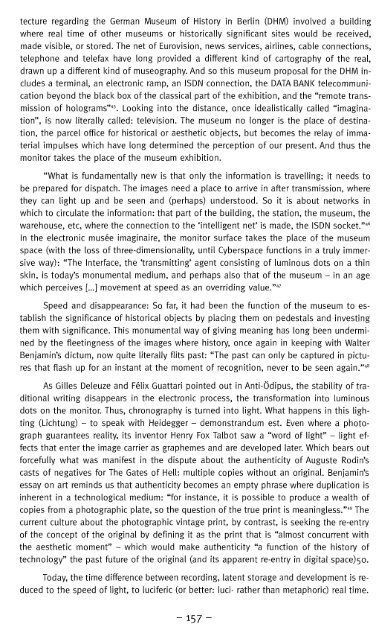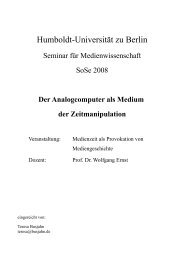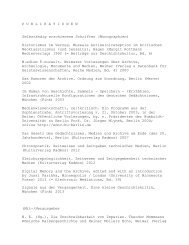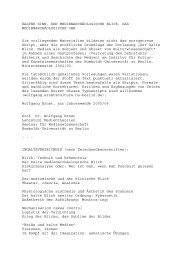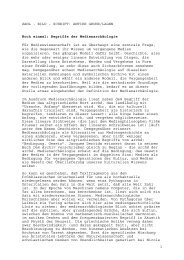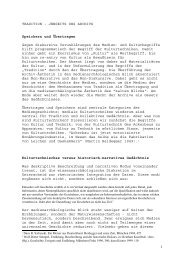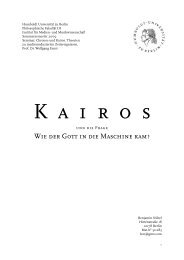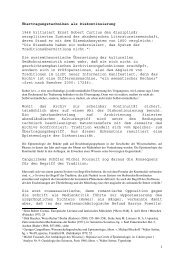Download - Medienwissenschaft
Download - Medienwissenschaft
Download - Medienwissenschaft
You also want an ePaper? Increase the reach of your titles
YUMPU automatically turns print PDFs into web optimized ePapers that Google loves.
tecture regarding the German Museum of History in Berlin (DHM) involved a building<br />
where real time of other museums or historically significant sites would be received,<br />
made visible, or stored. The net of Eurovision, news services, airlines, cable connections,<br />
telephone and telefax have long provided a different kind of cartography of the real,<br />
drawn up a different kind of museography. And so this museum proposal for the DHM includes<br />
a terminal, an electronic ramp, an ISDN connection, the DATA BANK telecommunication<br />
beyond the black box of the classical part of the exhibition, and the "remote transmission<br />
of holograms" 45 . Looking into the distance, once idealistically called "imagination",<br />
is now literally called: television. The museum no longer is the place of destination,<br />
the parcel office for historical or aesthetic objects, but becomes the relay of immaterial<br />
impulses which have long determined the perception of our present. And thus the<br />
monitor takes the place of the museum exhibition.<br />
"What is fundamentally new is that only the information is travelling; it needs to<br />
be prepared for dispatch. The images need a place to arrive in after transmission, where<br />
they can light up and be seen and (perhaps) understood. So it is about networks in<br />
which to circulate the information: that part of the building, the station, the museum, the<br />
warehouse, etc, where the connection to the 'intelligent net' is made, the ISDN socket." 46<br />
In the electronic musee imaginaire, the monitor surface takes the place of the museum<br />
space (with the loss of three-dimensionality, until Cyberspace functions in a truly immersive<br />
way): "The Interface, the 'transmitting' agent consisting of luminous dots on a thin<br />
skin, is today's monumental medium, and perhaps also that of the museum - in an age<br />
which perceives [...] movement at speed as an overriding value." 47<br />
Speed and disappearance: So far, it had been the function of the museum to establish<br />
the significance of historical objects by placing them on pedestals and investing<br />
them with significance. This monumental way of giving meaning has long been undermined<br />
by the fleetingness of the images where history, once again in keeping with Walter<br />
Benjamin's dictum, now quite literally flits past: "The past can only be captured in pictures<br />
that flash up for an instant at the moment of recognition, never to be seen again." 48<br />
As Gilles Deleuze and Felix Guattari pointed out in Anti-Ödipus, the stability of traditional<br />
writing disappears in the electronic process, the transformation into luminous<br />
dots on the monitor. Thus, chronography is turned into light. What happens in this lighting<br />
(Lichtung) - to speak with Heidegger - demonstrandum est. Even where a photograph<br />
guarantees reality, its inventor Henry Fox Talbot saw a "word of light" - light effects<br />
that enter the image carrier as graphemes and are developed later. Which bears out<br />
forcefully what was manifest in the dispute about the authenticity of Auguste Rodin's<br />
casts of negatives for The Gates of Hell: multiple copies without an original. Benjamin's<br />
essay on art reminds us that authenticity becomes an empty phrase where duplication is<br />
inherent in a technological medium: "for instance, it is possible to produce a wealth of<br />
copies from a photographic plate, so the question of the true print is meaningless." 49 The<br />
current culture about the photographic vintage print, by contrast, is seeking the re-entry<br />
of the concept of the original by defining it as the print that is "almost concurrent with<br />
the aesthetic moment" - which would make authenticity "a function of the history of<br />
technology" the past future of the original (and its apparent re-entry in digital space)5o.<br />
Today, the time difference between recording, latent storage and development is reduced<br />
to the speed of light, to luciferic (or better: luci- rather than metaphoric) real time.<br />
-157-


